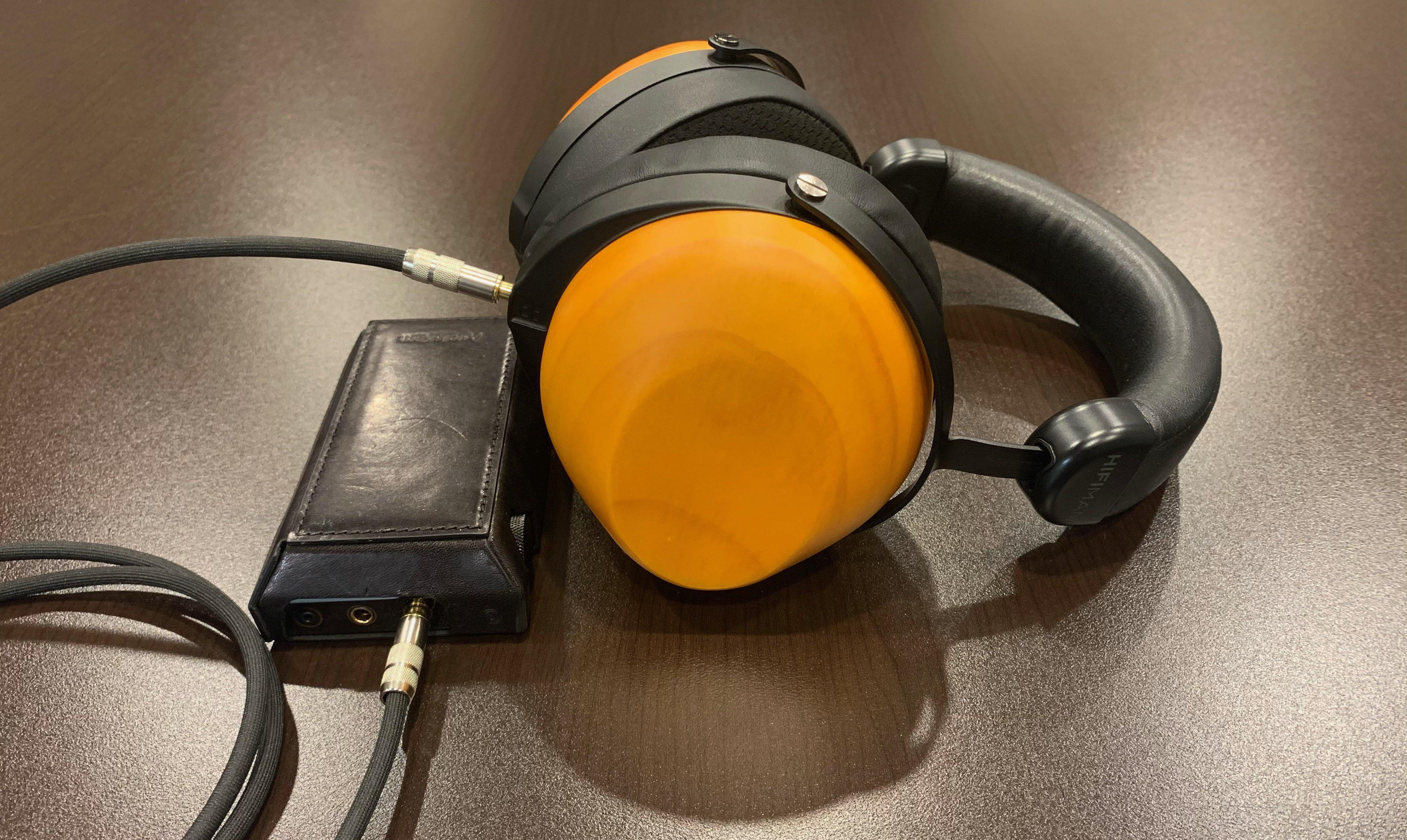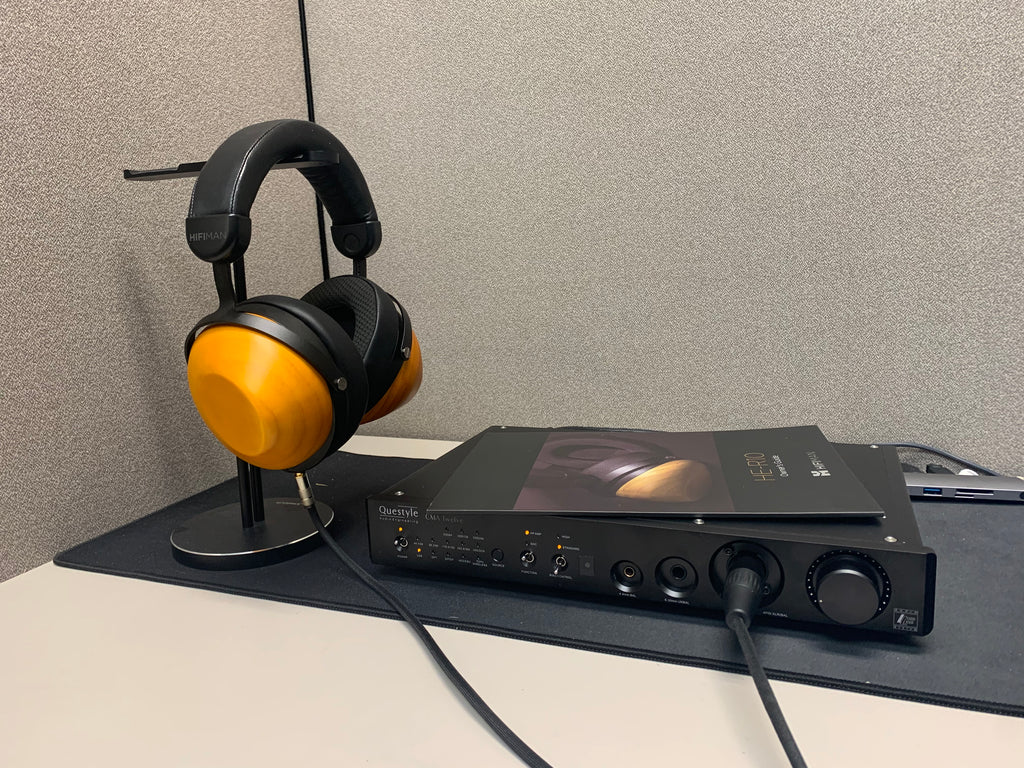In addition to their flagship closed-back headphone, the HE-R10P, HIFIMAN released another closed-back model, which utilizes a similar design at one third the price, the HE-R10D. While the names might look like participants in a robot boss fight from a 90s video game, the D and P simply denote whether the model uses Planar or Dynamic drivers. Today we’ll be talking about the HE-R10D, the dynamic version.
The Build and Design
The HE-R10D’s packaging and general design is almost identical to the HE-R10P. So you could say that you’re getting $5499 level packaging at $1299 – or I suppose you could infer something else with that information, but I won’t. Either way, you get three cables with HIFIMAN’s new design: a balanced/XLR, a 6.3mm unbalanced, and a 3.5mm unbalanced. Like the HE-R10P, the cables use a single TRRS connection on the left earcup, rather than the dual connection like previous models. The HE-R10D is also compatible with HIFIMAN’s BlueMini which allows wireless Bluetooth playback. All of this comes in a faux leather-wrapped wood box, which adds a sense of premium presentation to the whole affair.
The headphones themselves are medium weight and generally comfortable to wear. The band has a simple adjustable mechanism, and a cushioned strap. The earpads are comfortable and breathable – maybe a little bit too breathable as the isolation isn’t quite as good as you might hope. The earcups are, of course, large and shaped as they are for sound engineering purposes and not for fashion, but I could imagine someone (not me) wearing these out as a bold fashion statement. Honestly, it’s all very practical. The various components don’t necessarily look or feel premium or flashy, but they’re comfortable and functional, and the overall package is solid, so the question remains: how do they sound?
The Sound
While the general tonality of the HE-R10D is well constructed – and it’s bass performance is particularly solid – the star of the show is the stereo image. The sound signature is generally well-balanced, but roll-offs on the top and bottom sometimes leave the sound feeling slightly compressed. There’s generally a good punch to the bass, but the low-end misses the bottom end of that visceral rumble. Likewise, some more treble oriented instruments, like cymbals, get a nice sizzle, but don’t quite have the air or shimmer at the very top.
The soundstage and imaging performance comes with less caveats. In absolute terms, the soundstage is tall and deep, though not exceedingly wide. But just taking closed back headphones for comparison, the soundstage is quite impressive. The imaging is, without qualification, objectively excellent and genuinely holographic. Instruments have a real sense of placement in three-dimensional space, and when songs use stereo panning there’s a real sense of movement through that space.
Listening to “Happy Return/Ascendant Here on In” by Steven Wilson, the first thing that strikes me is the positioning and spacing between the piano, acoustic guitar, and vocal on the intro first verse, with the instruments off to either side, and the vocal close and intimate in front and in between. When the full band enters on the second verse, the strong layering is apparent with multiple guitars, piano, keys, drums, bass, and vocals all weaving in and out. As the band builds to a crescendo each element is coherent and the whole is powerful and cohesive.
On Herbie Hancock’s “Chameleon,” there’s a great sense of a large empty space, with each musician spread out across it. The bass drum has a powerful physical kick to it, and the snare has a tight snap. The horns are smooth, piercing through the rest of the layers, but without sounding harsh. Throughout the song, different layers and instruments were nicely highlighted, and the presentation remained tight and well organized.
Jewel’s “Foolish Games” puts her vocals up close and personal. The HE-R10D presents a real sense of movement from left to right as the piano part moves from low to high. The instrument and vocal timbre is warm and natural. The vocal presentation feels almost too honest at points, revealing emotion, but also some rough edges in the inflections. Overall there’s a strong sense of an honest, intimate, personal performance.
For testing, I tend to stick with what I like for my main units, specifically the Questyle CMA Twelve and the Astell&Kern KANN Alpha. The HE-R10D doesn’t need a ton of power, so it will work with a phone, laptop, or low power DAP, but the soundstage does certainly appreciate getting desktop level power. For listening, I use a combination of Qobuz high-res streams, Spotify streams, and a selection of hi-res FLAC files. Both units play very nicely with the HE-R10P, both in balanced and unbalanced operation.
Comparison: Audio-Technica ATH-AWAS
The Audio-Technica ATH-AWAS is another wood cup, closed-back, dynamic driver headphone that provides a balance between overall tonality and technical performance, so it makes the perfect comparison point for the HIFIMAN HE-R10D. While there are a lot of similarities between the two headphones, there are some strong differences in terms of design and execution.
One of the most notable differences between the two are the build and design. Simply put, the ATH-AWAS provides a more premium look and feel. The Audio-Technicas also have better isolation – keeping your music in, and outside sounds out. But that’s a point where there were obviously different design goals in mind, with HIFIMAN attempting to achieve a higher level of performance with a unique design as opposed to Audio-Technica wanting to deliver something more traditional with incremental improvements over its predecessors.
In terms of sound, both have similar sound signatures, but you can see some of the advantages of HIFIMAN’s design come to bear. The ATH-AWAS has a slightly bright sound, with a good amount of bass presence, but somewhat weak extension in the subbass. It has a great soundstage for a closed-back and solid imaging as well. The HE-R10D manages to provide a larger soundstage, and comparable imaging, as well as better sense of impact in the bass and a bit more subbass extension. In terms of the over tonality, I prefer the HE-R10D, but the ATH-AWAS does have the advantage in feeling like its dynamics are less compressed. The extra brightness adds a bit more life and air into the sound.
It seems like the extra space really does make a difference in the bass performance, and the ability to balance the overall tonality better while still providing excellent technical performance. If you’re going to wear them in an office environment or out of the house, the ATH-AWAS has the clear advantage in both the looks and the better isolation, but the HE-R10D has a stronger overall sonic performance.
The Bottom Line
The HE-R10D was sure to be controversial from the moment the first images were released. Spending some time with it though, it’s clear that HIFIMAN’s team built a great set of headphones. The design is love it or hate it, and the build quality isn’t particularly competitive in this price range, but the HE-R10D provides the combination of an addictive tuning and peak closed-back stereo imaging that lifts it above the competition.








